Force and Motion | Term 1 Unit 2 | 7th Science - Questions Answers | 7th Science : Term 1 Unit 2 : Force and Motion
Chapter: 7th Science : Term 1 Unit 2 : Force and Motion
Questions Answers
Evaluation
I. Choose the best answer.
1. A particle is moving in a
circular path of radius r. The displacement after half a circle would be
a.
Zerob.
b.
R
c.
2 r.
d.
r / 2
Answer : c. 2r
2.
Which of the following figures represent uniform motion of a moving object
correctly?
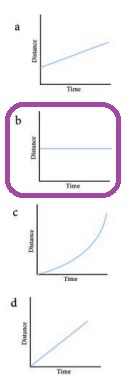
3.
Suppose a boy is enjoying a ride on a marry go round which is moving with a
constant speed of 10 m/s. It implies that the boy is
a. at rest
b. moving with no acceleration
c. in accelerated motion
d. moving with uniform velocity
Answer : c. in an accelerated motion
4. From the given v-t graph it can be inferred that the object is
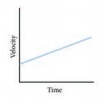
a. in uniform motion
b. at rest
c. in non uniform motion
d. moving with uniform acceleration
Answer : d. moving with uniform acceleration
5.
How can we increase the stability of an object?
a.
lowering the centre of gravity
b.
raise the centre of gravity
c.
increasing the height of the object
d. shortening the base of the object
Answer : a. lowering the centre of gravity
II. Fill in the blanks.
1. The shortest distance between the
two places is displacement.
2. The rate of change of velocity
is acceleration.
3. If the velocity of an object
increases withrespect to time, then the object is said to be in positive acceleration.
4. The slope of the speedŌĆōtime graph
gives acceleration of a body.
5. In neutral equilibrium its
centre of gravity remains at the same height when it is displaced.
III. Match the following:
Displacement - Knot
Light travels through vacuum - Geometric centre
Speed of ship - Metre
Centre of gravity of the geometrical
shaped object - Larger base area
Stability
- Uniform
velocity
Answer:
1. Displacement - Metre
2. Light travels
through vacuum - Uniform velocity
3. Speed of ship - Knot
4. Centre of
gravity of the geometrical shaped object- Geometric centre
5. Stability - Larger base area
IV. Analogy
1. velocity : metre/ second : :
acceleration : meter / second2.
2. length of scale : metre : : speed
of aeroplane: knot.
3. displacement / time : velocity :
: speed / time: acceleration.
V. Give very short answer.
1.
All objects having uniform speed need not have uniform velocity. Describe with
the help of examples.
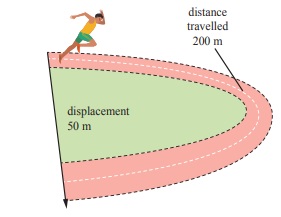
If an athlete in the diagram takes 25 s to complete a 200 m
sprint event. Then
Speed = distance / time
= 200 / 25
= 8 m / s
He travels with an uniform speed since he covers equal distances
in equal intervals of time.
velocity = displacement / time
= 50 / 25
= 2 m/s
Ōł┤ Velocity is not uniform because there is change in direction.
2.
ŌĆ£She moves at a constant speed in a constant directionŌĆØ. Rephrase the same
sentence in fewer words using concepts related to motion.
Saphira moves with a
uniform velocity.
3.
Correct your friend who says ŌĆ£The acceleration gives the idea of how fast the
position changesŌĆØ.
The acceleration gives the
idea of change of velocity with time.
V. Give short answer.
1.
Show the shape of the distance ŌĆō time graph for the motion in the following
cases.
a.
A bus moving with a constant speed.
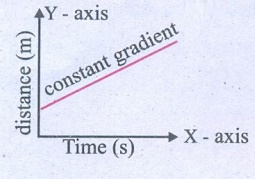
b.
A car parked on a road side.

2.
Distinguish between speed and velocity.
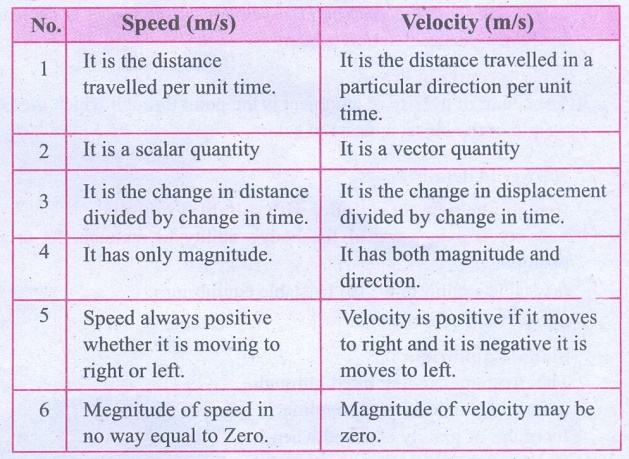
Speed (m/s)
1. It is the distance travelled per unit time.
2. It is a scalar quantity
3. It is the change in distance divided by change in time.
4. It has only magnitude.
5. Speed always positive whether it is moving to right or left.
6. Megnitude of speed in no way equal to Zero.
Velocity (m/s)
1. It is the distance travelled in a particular direction per
unit time.
2. It is a vector quantity
3. It is the change in displacement divided by change in time.
4. It has both magnitude and direction.
5. Velocity is positive if it moves to right and it is negative
it is moves to left.
6. Magnitude of velocity may be zero.
3.
What do you mean by constant acceleration?
An object undergoes uniform (constant) acceleration when the
change (increase or decrease) in its velocity for every unit of time is the
same. Table shows a moving bus with uniform acceleration.
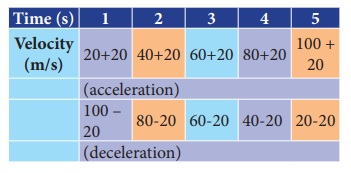
When the velocity of the object is increasing by 20 m/s the
acceleration is 20 m/s2. When the velocity of the object is
decreasing by 20 m/s the deceleration is 20 m/s2.
When the velocity of the object is decreasing by 20m/s the deceleration is 20 m/s2.
Deceleration = Decrease in velocity / Deceleration = t = 20/20 = 1s
The velocity of the object is decreasing by 20m/s in one second.
4.
What is centre of gravity ?
The centre of gravity of an object is the point through which
the entire weight of the object appears to act.
VII. Answer in detail.
1.
Explain the types of stability with suitable examples.
Stability is a measure of the body's ability to maintain its
original position.
(a) Stable equilibrium
(b) Unstable equilibrium
(c) Neutral equlibrium
Stable Equlibrium :
The frustum can be tilted through quite a big angle without
toppling. Its centre of gravity is raised when it is displaced.
The vertical line thorugh its centre of gravity still falls
within its base. So it can return to its original position.
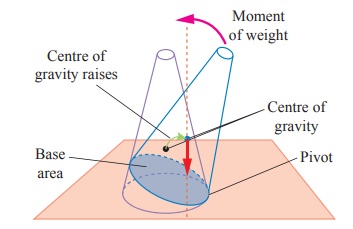
Unstable Equilibrium :
The frustum will topple with the slightest tilting. Its centre
of gravity is lowered when it is displaced.
The vertical line through its centre of gravity falls outside
its base.ŌĆā

Neutral Equilibrium :
(d) It does not cause to topple.
(e) The frustum will rolls about but does not topple.
(f) Its centre of gravity ramains at the same height when it it
displaced.
(g) The body will stay in any position to which it has been
displaced.
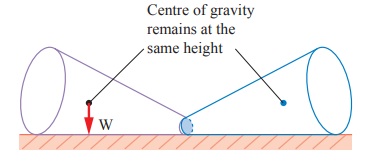
2.
Write about the experiment to find the centre of gravity of the irregularly
shaped plate.
Determination of centre of gravity of irregular shaped objects.
Apparatus : Irregularly shaped plate string, pendulum bob,
stand.
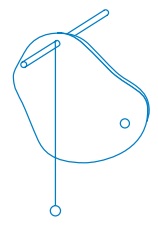
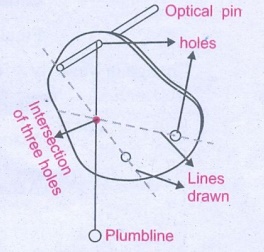
1. Make three holes in the lamina.
2. Suspend the lamina from the optical pin through one of the
holes as shown.
3. Suspend the plumbline from the pin and mark and position of
the plumbline on the lamina.
4. Draw lines on the lamina representing the positions of the
plumbline.
5. Repeat the above steps for the holes.
6. Label the intersection of the three lines as X, the position
of the centre of gravity of the lamina.
VIII. Numerical problems.
1.
Geetha takes 15 minutes from her house to reach her school on a bicycle. If the
bicycle has a speed of 2 m/s, calculate the distance between her house and the
school.
Time taken by Geetha = 15 minutes
= 15 ├Ś 60
seconds
= 900 s
Her speed = 2 m/s
Distanced moved by her in 1 s = 2 m
Ōł┤ in 900 s = (900 s / 1 s) ├Ś 2 m
= 1800
m = 1.8 km
2.
A car started from rest and travelling with velocity of 20 m /s in 10 s. What
is its acceleration?
Initial velocity (U) = 0 m /s
Final Velocity (V) = 20 m
/s
Change in Velocity = (V - U) = (20 ŌĆō 0 ) = 20 m/s
Time taken for this change in velocity = 10 s
Acceleration = change in velocity / time
a = 20 m/s / 10 s = 2 m/s2
3.A
bus can accelerate with an acceleration 1 m / s2. Find the minimum
time for the bus to reach the speed of 100 km / s from 50 km / s.
Acceleration of the bus a = 1 m/s2
Change in speed = (V - U) = (100 - 50) km / hr
= 50
├Ś 1000 m/hr
= (50000
/ 60) m/ minute
= (50,000 / 60├Ś60 )
m/second
Time taken for this change of speedŌĆā= change in speed /
acceleration
= [ 50,000 m/s ] / [ 60 ├Ś
60 ├Ś 1 ms2] = 125 /9 s
= 13.89 seconds
IX. Fill in the boxes.

Related Topics